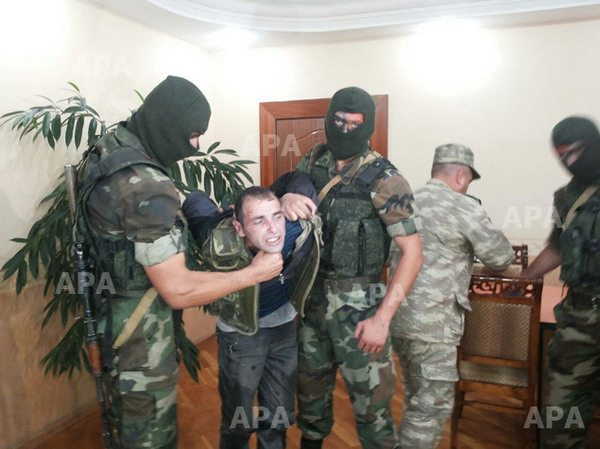Special for the Armenian Weekly
On Mon., Oct. 27, the presidents of Armenia and Azerbaijan met in Paris for another set of negotiations on the Nagorno-Karabagh conflict.

On July 11, footage appeared on Armenian TV of one of the captives, Dilgam Askerov, being dragged by masked Special Forces officers before a senior army official.
The talks came on the heels of a summer that saw the deadliest fighting between the two sides in over two decades. At least 30 soldiers died in one week of border clashes in late July and early August, a total higher than all of the casualties seen in 2013. The United States, Russia, and the European Union all issued statements calling for a diffusion of tensions and respect for the 1994 ceasefire. In the meantime, Azerbaijani President Ilham Aliyev went on Twitter declaring, “The war is not over. Only the first stage of it is.”
What sparked the burst of combat remains unclear. Theories abound—from developments in Ukraine and Russian meddling, to testing the combat readiness of the opposing side.
But there is one very important variable that receives little attention: the treatment of civilians and enemy captives.
This year began with the capture and torture of 77-year-old Mamikon Khojoyan, a mentally ill villager from northern Armenia who accidentally crossed the border. Azerbaijani authorities paraded him on TV as a “saboteur,” showing him with a cast over his arm and ridiculously claiming he worked for the Armenian secret service.
When he was returned home one month later, I visited him, along with the Foundation Against the Violation of Law. It was beyond disturbing to see this helpless man lying in a hospital bed with signs of torture all over his body. A forensic exam later found toxic substances in his blood—believed to be the cause of his death on May 20.
The way Khojoyan was treated symbolizes an ongoing policy of systematic violence against Armenians by the Azerbaijani government. It is such violence that helped propel the Karabagh movement in the first place, and continues to convince most Armenians that there is little hope for normal relations with their neighbor. Open displays of such brutality—coupled with bellicose war rhetoric and the official celebration of the likes of Ramil Safarov by Baku—only serve to heighten tensions.

Karen Petrosyan was quickly apprehended, labeled a “saboteur,” and pronounced dead under Azerbaijani custody the following day.
Although the actions and pronouncements of the Armenian government are much more reserved, it has not been immune from acts that have increased the risk of armed conflict.
In early July, about one month before the bloody border clashes, three Azerbaijani citizens crossed into Kelbajar, in Karabagh, in what Armenian authorities described as a sabotage mission. According to official reports, the men were armed and responsible for the death of a local teenager, as well as the killing of an army officer and wounding of a woman in a shootout. One of the men, Hasan Hasanov, was killed in the attack; the other two are currently being tried on criminal charges. Interestingly enough, their trial began in Stepanakert on Oct. 27—the same day the presidents began talks in Paris.
On July 11, footage appeared on Armenian TV of one of the captives, Dilgam Askerov, being dragged by masked Special Forces officers before a senior army official. Images of the other man were also widely distributed to the media, in clear violation of the Geneva Conventions’ ban against “insults and public curiosity” of prisoners of war.
This publicly staged humiliation of the Azeri captives surely aggravated the subsequent tension along the border this summer. In his thorough analysis of the incident, Emil Sanamyan suggests that the clashes in late July and early August may have even been motivated by a desperate attempt on the part of Azerbaijan to capture Armenians as retaliation for this incident.
Ironically, Azerbaijan’s wishes came true away from the theater of combat when, on Aug. 7, a villager in northern Armenia accidentally crossed the border a few kilometers from his frontier home. Karen Petrosyan was quickly apprehended, labeled a “saboteur,” and pronounced dead under Azerbaijani custody the following day.
Upon his capture, Petrosyan was dragged before TV cameras by masked men in army fatigues and shown interrogated by an Azerbaijani general, almost identical to how Askerov was paraded one month earlier. The similarity of this display further suggests that the flare-up in fighting was motivated by retaliation for the capture of the three Azerbaijani citizens in Kelbajar. Indeed, the clashes effectively ended after Petrosyan was killed.
Although the cases of Khojoyan and Petrosyan—unarmed civilians who ended up dead—differ sharply from the Azerbaijanis who were captured in Karabagh—with the latter admitting to being armed, and currently undergoing trial for the death of a juvenile—the uncharacteristic manner in which Askerov was officially shown up on TV only added fuel to the fire. In contrast, we have seen how more measured approaches based on international norms can actually help diffuse high tensions.
Thus, while pundits speak about geopolitical maneuvering, peace proposals, and dialogue, a more important matter is to reduce the risk of actions dictated by incitement and retaliation. These provocations can quickly escalate into a dangerous spiral of violence.
Given the porous nature of the border separating Armenia from Azerbaijan, we are likely to see other cases of apprehended civilians and combatants in the future. It is thus essential that negotiations address the responsibility of both sides in refraining from public humiliation and ill treatment. An adherence to basic standards of humanitarian practice is not only the obligation of both states before international law, it is essential in avoiding an unexpected and unwarranted escalation into further conflict.
The post Protecting Humanitarian Norms, Avoiding Escalation appeared first on Armenian Weekly.